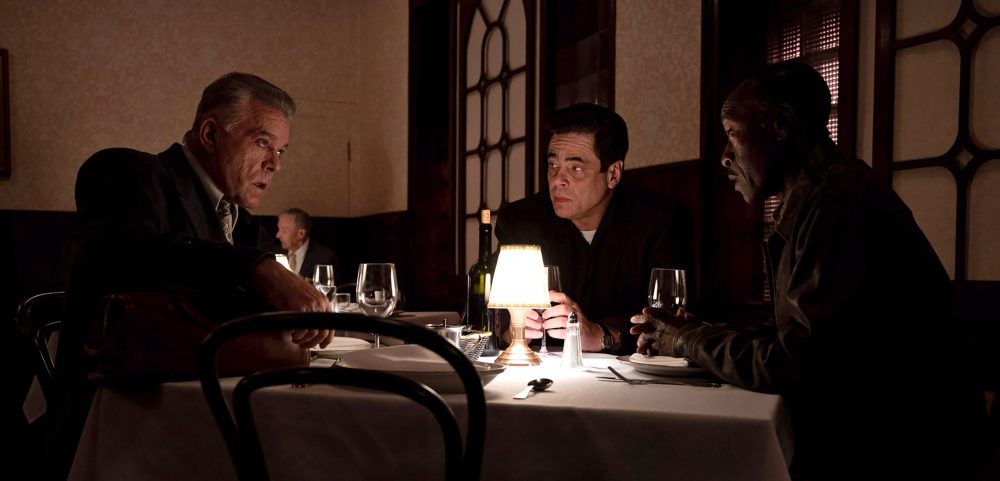
There’s nothing like a good crime flick or heist story and the latest film from director Steven Soderbergh mixes elements of both while delving into the shadowy history of American automotive politics and offering a healthy dose of social commentary. Recently released from prison, Curtis Goynes (Don Cheadle) accepts what he thinks is just another simple job in 1950 Detroit’s seedy criminal underworld. He joins Richard Russo (Benecio Del Toro) and Charley (Kieran Culkin) at the behest of Doug Jones (Brendan Fraser) to accost the family of Matt Wertz (David Harbour) while Wertz retrieves a mysterious document from a safe in his office. Soon enough, the simple job descends into the tangled underbelly of a rapidly changing Detroit and a sociopolitical battle that turns into a high stakes cat and mouse game with dire consequences.
As the film’s plot slowly develops, No Sudden Move first catches your attention with how stylishly it is designed and shot by Soderbergh and production designer Hannah Beachler. Beachler imbues the film’s set pieces with immaculate period accurate design that brings its Norman Rockwell era setting to life. One aspect of the effort to create a fully immersive 1950s feel for the film is Soderbergh’s use of Kowa Prominar Lenses, most popularly used in 1960s Japanese cinema. These period accurate lenses create an extremely wide angle, almost peephole type of look that stay true to the time and nod knowingly at the past. In addition to the lenses fitting the film’s setting, the peephole type vantage creates a feeling almost as if the audience is surveilling the various criminals and shady characters in the story, unraveling the intrigue and conspiracy like we’re investigators on the case in addition to attentive viewers. It’s an inspired aesthetic choice from the filmmakers that is sure to be polarizing; some viewers annoyed by the obstructed viewing with others appreciative of the nod toward history and possible visual storytelling aspect described in the preceding sentence. This reviewer appreciates the attempt at trying something different and the experience that it could be attempting to impart on the audience.
Soderbergh’s recent cinematic output has explored the nexus of money, crime, and institutional power structures and No Sudden Move is no exception, examining the collusion within the auto industry at its apex and how the criminal underworld found itself intersecting with the machinations of corporate power. This is encapsulated during a scene at the film’s climax that finds Russo counting hundreds of thousands of dollars while Goynes and auto executive Michael Lowenstein talk about the MacGuffin and the sociological corruption it represents that is at the heart of the film’s story. While not exactly subtle, the scene highlights No Sudden Move’s theme nonetheless. While the machinations of Goynes and Russo’s scheme to get out of this conundrum alive and paid wealthy can seem convoluted at times due to the slow reveal of what exactly they are in possession of and why it is so highly sought after, it largely works due to the performances of the cast and the winding circumstances, shadowy changing motives of all involved, and the engaging nature of it all.
No Sudden Move is a callback not only to a bygone era, but to a style and genre of film that audiences aren’t treated to nearly enough anymore. Director Steven Soderbergh mixes social commentary with a sleek, stylish, engrossing crime drama with enough twists and turns to keep viewers engaged throughout. The all-star cast all perform capably and play well off of each other, investing you in the fate of multiple characters and their multiple subplots. No Sudden Move is the latest entry on a strong resume for Soderbergh.
Image: Warner Bros.

